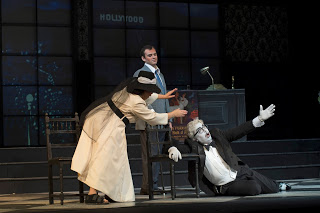Don Pasquale Director’s Notes: Chuck Hudson
 |
| Photo: Philip Groshong for Cincinnati Opera |
With DON PASQUALE, Donizetti gives us champagne for music
and so the comedic style in the acting must match this excellence or it would
be like mixing bubbles with beer! I had the privilege of working with a master
of comedy, Marcel Marceau. At his school in Paris, Marceau had us study the
various styles of comedy from the Italian Commedia dell’Arte to his own comic
inspirations: Charlie Chaplin, Buster Keaton, Harold Lloyd, and other actors of
le Cinéma Muet. It was their virtuosity,
their “musicality” in style that struck Marceau. Their comic dignity represented
the champagne of Comedy as opposed to the stylistic beer of Slapstick or
Vaudeville. Marceau also drilled us in the details of his own comic masterpieces,
working the specificity, style, and that elusive skill, Comic Timing. Highlights
of touring with Marceau came on the off-nights in a studio improvising
together. He’d put me on stage and toss out a theme and I would “play.” He gave
me specific stylistic directions: “make the same action tragic, now comic, now
dark comedy, now Baroque comedy, now Melodrama….” To increase the subtlety he
would say, “Now find the tragic in the comic” or “find the comic in the
tragic.” I learned that I could change the context or even the meaning simply
by changing where and when to “take” to the audience. These silent asides would
make or break the comedy and could generate cascades of laughter. I love
honoring his influence by inserting flowers from his bouquet into a show now
and then, so we have inserted a few into this production—rifffing on Bip Commits Suicide, The Mask Maker, and
The Pickpocket’s Nightmare.
and so the comedic style in the acting must match this excellence or it would
be like mixing bubbles with beer! I had the privilege of working with a master
of comedy, Marcel Marceau. At his school in Paris, Marceau had us study the
various styles of comedy from the Italian Commedia dell’Arte to his own comic
inspirations: Charlie Chaplin, Buster Keaton, Harold Lloyd, and other actors of
le Cinéma Muet. It was their virtuosity,
their “musicality” in style that struck Marceau. Their comic dignity represented
the champagne of Comedy as opposed to the stylistic beer of Slapstick or
Vaudeville. Marceau also drilled us in the details of his own comic masterpieces,
working the specificity, style, and that elusive skill, Comic Timing. Highlights
of touring with Marceau came on the off-nights in a studio improvising
together. He’d put me on stage and toss out a theme and I would “play.” He gave
me specific stylistic directions: “make the same action tragic, now comic, now
dark comedy, now Baroque comedy, now Melodrama….” To increase the subtlety he
would say, “Now find the tragic in the comic” or “find the comic in the
tragic.” I learned that I could change the context or even the meaning simply
by changing where and when to “take” to the audience. These silent asides would
make or break the comedy and could generate cascades of laughter. I love
honoring his influence by inserting flowers from his bouquet into a show now
and then, so we have inserted a few into this production—rifffing on Bip Commits Suicide, The Mask Maker, and
The Pickpocket’s Nightmare.
We wanted to create an environment that would allow the comic
virtuosity to work hand in hand with the vocal virtuosity of Opera. When the
design team and I settled on SUNSET BOULEVARD as the inspiration for this
production, the collaboration and creativity flowed. Having singers play Hollywood
actors who are playing roles opened up a world of comic possibilities. I have
always been amazed with the “theatre magic” of the costume changes during a
Japanese Kabuki performance—a Samurai Warrior turns into a Fox right before
your eyes, which is not only part of the fun, it is a playful way for us to
portray in a theatre the special effects we expect in a movie. Like a Busby
Berkeley chorus becoming a kaleidoscope of human action, even our set
transforms one large element into a completely different object in another
scene.
virtuosity to work hand in hand with the vocal virtuosity of Opera. When the
design team and I settled on SUNSET BOULEVARD as the inspiration for this
production, the collaboration and creativity flowed. Having singers play Hollywood
actors who are playing roles opened up a world of comic possibilities. I have
always been amazed with the “theatre magic” of the costume changes during a
Japanese Kabuki performance—a Samurai Warrior turns into a Fox right before
your eyes, which is not only part of the fun, it is a playful way for us to
portray in a theatre the special effects we expect in a movie. Like a Busby
Berkeley chorus becoming a kaleidoscope of human action, even our set
transforms one large element into a completely different object in another
scene.
One of the trickiest things about this opera is that there
is only one female character, Norina. When we meet her, we are not introduced
to a girl but to a woman. She is neither innocent of the ways of men nor innocent
of the ways of the world. In her introductory aria, Norina revisits the Fairy
Tale Romance that she and all young girls are taught to believe, and she knows
from experience that this is not what real love is. In our own Post-Romantic
world where Disney Princesses have more chutzpah than their Barbie Doll
predecessors, Norina is an intelligent and educated young woman who has
experienced life, and yet is not so jaded by her experience that she no longer
believes in love.
is only one female character, Norina. When we meet her, we are not introduced
to a girl but to a woman. She is neither innocent of the ways of men nor innocent
of the ways of the world. In her introductory aria, Norina revisits the Fairy
Tale Romance that she and all young girls are taught to believe, and she knows
from experience that this is not what real love is. In our own Post-Romantic
world where Disney Princesses have more chutzpah than their Barbie Doll
predecessors, Norina is an intelligent and educated young woman who has
experienced life, and yet is not so jaded by her experience that she no longer
believes in love.
Similar to the relationship between Rosina and Figaro in
Rossini’s Il barbiere di Siviglia, Dr. Malatesta never tells Norina what to do.
Like Figaro, he is Socratic in his instruction. He values and supports the
cleverness and intelligence of his protégée, leading Norina to discover her own
solutions by thinking them out logically. He even trusts her to improvise her
own text and actions disguised as the shrewish Sofronia.
Rossini’s Il barbiere di Siviglia, Dr. Malatesta never tells Norina what to do.
Like Figaro, he is Socratic in his instruction. He values and supports the
cleverness and intelligence of his protégée, leading Norina to discover her own
solutions by thinking them out logically. He even trusts her to improvise her
own text and actions disguised as the shrewish Sofronia.
If Norina is the Only Woman, she must therefore represent Every
Woman. If the real Norina is in any way shrewish then she is not in disguise as
the shrew Sofronia, and what a two-dimensional stereotype of women that would be.
No, Norina is written as a three-dimensional woman possessing flaws as well as
talents. We may not agree with some of her choices—restoring our faith in a
woman who has just slapped an old man to the ground is quite a challenge! Perhaps
Norina goes too far, and she must recognize this, too. Restoring the comedy
from that dark situation is a pivotal moment in the show.
Woman. If the real Norina is in any way shrewish then she is not in disguise as
the shrew Sofronia, and what a two-dimensional stereotype of women that would be.
No, Norina is written as a three-dimensional woman possessing flaws as well as
talents. We may not agree with some of her choices—restoring our faith in a
woman who has just slapped an old man to the ground is quite a challenge! Perhaps
Norina goes too far, and she must recognize this, too. Restoring the comedy
from that dark situation is a pivotal moment in the show.
On the first day of rehearsal I presented the singers with
Marceau’s Comic Timing Exercise—a specific and yet simple sequence of movements
that allows comedy to flourish. Armed with this technique, we got to work!
Although he is no longer with us, Marceau’s style and his love of style live on
in those of us who worked with him directly. I am privileged to pass it along
to the next generation of performers including actors, movement artists, and
opera singers. As with all of them, so with you, I share the eulogy for Chuckles the Clown on The Mary Tyler
Moore Show:
Marceau’s Comic Timing Exercise—a specific and yet simple sequence of movements
that allows comedy to flourish. Armed with this technique, we got to work!
Although he is no longer with us, Marceau’s style and his love of style live on
in those of us who worked with him directly. I am privileged to pass it along
to the next generation of performers including actors, movement artists, and
opera singers. As with all of them, so with you, I share the eulogy for Chuckles the Clown on The Mary Tyler
Moore Show:
“A little song, a little dance, a little seltzer down your
pants.”
pants.”
Learn more about Chuck Hudson: http://chdirector.com/
Usage of any images on this blog is restricted to The Atlanta Opera and approved news websites. Any other usage, particularly for professional purposes, must have written permission. For additional information, please contact The Atlanta Opera at 404.881.8801.


